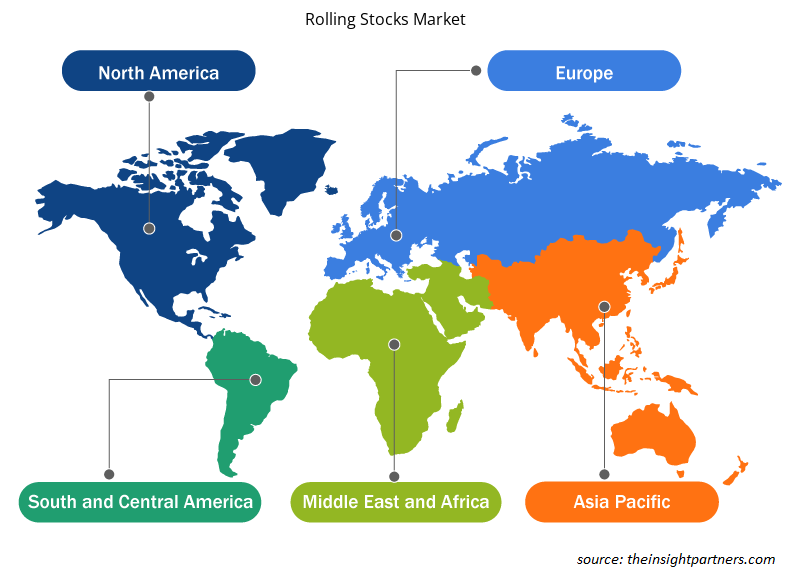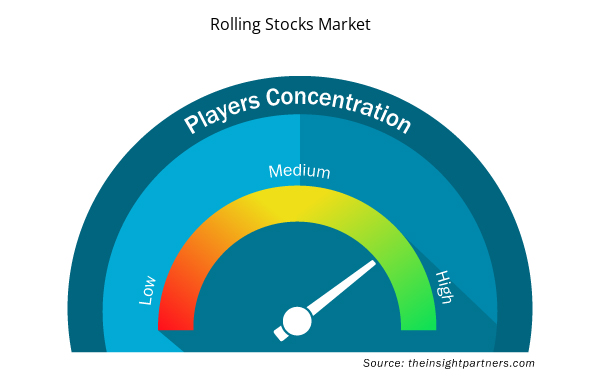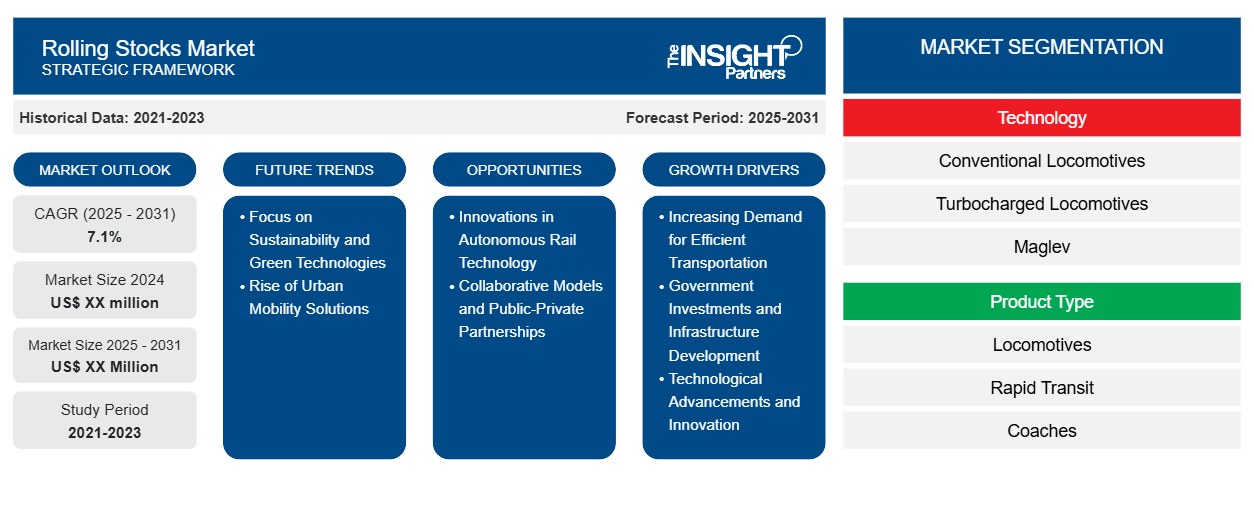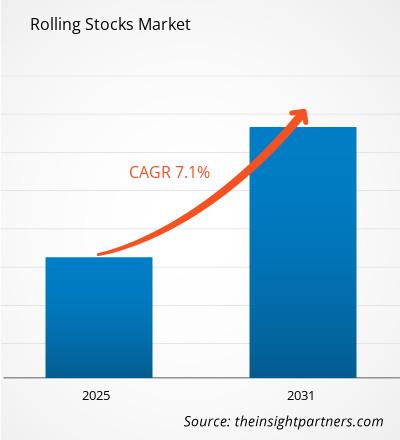Le marché du matériel roulant devrait enregistrer un TCAC de 7,1 % de 2023 à 2031, avec une taille de marché passant de XX millions USD en 2023 à XX millions USD d'ici 2031.
Le rapport est segmenté par technologie (locomotives conventionnelles, locomotives turbocompressées, Maglev) ; type de produit (locomotives, transport rapide, autocars, wagons, autres) ; application (transport de passagers, fret). L'analyse globale est ensuite décomposée au niveau régional et par principaux pays. Le rapport offre la valeur en USD pour l'analyse et les segments ci-dessus.
Objectif du rapport
Le rapport Rolling Stocks Market de The Insight Partners vise à décrire le paysage actuel et la croissance future, les principaux facteurs moteurs, les défis et les opportunités. Cela fournira des informations à diverses parties prenantes commerciales, telles que :
- Fournisseurs/fabricants de technologie : pour comprendre l’évolution de la dynamique du marché et connaître les opportunités de croissance potentielles, leur permettant de prendre des décisions stratégiques éclairées.
- Investisseurs : Effectuer une analyse complète des tendances concernant le taux de croissance du marché, les projections financières du marché et les opportunités qui existent tout au long de la chaîne de valeur.
- Organismes de réglementation : Réglementer les politiques et surveiller les activités du marché dans le but de minimiser les abus, de préserver la confiance des investisseurs et de maintenir l’intégrité et la stabilité du marché.
Segmentation du marché du matériel roulant
Technologie
- Locomotives conventionnelles
- Locomotives turbocompressées
- Train à sustentation magnétique
Type de produit
- Locomotives
- Transport rapide
- Entraîneurs
- Wagons
- Autres
Application
- Transport de passagers
- Fret
Géographie
- Amérique du Nord
- Europe
- Asie-Pacifique
- Amérique du Sud et Amérique centrale
- Moyen-Orient et Afrique
Géographie
- Amérique du Nord
- Europe
- Asie-Pacifique
- Amérique du Sud et Amérique centrale
- Moyen-Orient et Afrique
Personnalisez ce rapport en fonction de vos besoins
Vous bénéficierez d'une personnalisation gratuite de n'importe quel rapport, y compris de certaines parties de ce rapport, d'une analyse au niveau des pays, d'un pack de données Excel, ainsi que d'offres et de remises exceptionnelles pour les start-ups et les universités.
- Obtenez les principales tendances clés du marché de ce rapport.Cet échantillon GRATUIT comprendra une analyse de données, allant des tendances du marché aux estimations et prévisions.
Facteurs de croissance du marché du matériel roulant
- Demande croissante de transports efficaces : L’un des principaux moteurs du marché du matériel roulant est la demande croissante de solutions de transport efficaces et fiables dans les secteurs des passagers et du fret. À mesure que l’urbanisation continue de progresser et que le commerce mondial se développe, il existe un besoin accru de systèmes ferroviaires modernisés capables de gérer des volumes croissants de passagers et de marchandises. Cette demande entraîne des investissements dans du nouveau matériel roulant, notamment des locomotives, des voitures de voyageurs et des wagons de marchandises, afin d’améliorer l’efficacité opérationnelle et de réduire les temps de trajet.
- Investissements publics et développement des infrastructures : les investissements publics importants dans le développement des infrastructures, notamment dans les réseaux ferroviaires, alimentent la croissance du marché du matériel roulant. De nombreux pays accordent la priorité à l’expansion et à la modernisation de leurs réseaux ferroviaires pour promouvoir un transport durable, réduire la congestion et améliorer la connectivité. Les partenariats public-privé (PPP) deviennent également plus courants, permettant l’acquisition de matériel roulant de pointe tout en répartissant les risques financiers. Ces investissements créent des opportunités pour les fabricants et les fournisseurs sur le marché du matériel roulant.
- Progrès technologiques et innovation : les progrès technologiques continus dans la conception, les matériaux et les systèmes du matériel roulant stimulent la croissance du marché. Des innovations telles que les matériaux légers, les systèmes de propulsion économes en énergie et les technologies de contrôle avancées améliorent les performances et la durabilité des trains. En outre, l'intégration de technologies numériques, telles que les capteurs de l'Internet des objets (IoT) pour la maintenance prédictive et la surveillance en temps réel, améliore l'efficacité opérationnelle et la sécurité. À mesure que ces technologies évoluent, elles créent de nouvelles opportunités pour les fabricants de développer du matériel roulant de nouvelle génération.
Tendances futures du marché du matériel roulant
- Accent sur la durabilité et les technologies vertes : On observe une tendance notable vers la durabilité sur le marché du matériel roulant, avec une attention croissante portée à la réduction des émissions de carbone et de la consommation d'énergie. Les opérateurs ferroviaires investissent de plus en plus dans les technologies vertes, telles que les locomotives électriques et hybrides, pour améliorer leur performance environnementale. Cette tendance est motivée par les pressions réglementaires et la sensibilisation du public au changement climatique. Les fabricants réagissent en développant des solutions de matériel roulant respectueuses de l'environnement qui répondent à ces objectifs de durabilité.
- L’essor des solutions de mobilité urbaine : La tendance vers des solutions de mobilité urbaine, notamment le métro léger et les trains de banlieue, gagne du terrain dans les zones urbaines. Alors que les villes cherchent à réduire les embouteillages et à promouvoir les transports publics, la demande de matériel roulant qui soutient les initiatives de mobilité urbaine augmente. Cela comprend le développement de systèmes modernes de métro léger, de tramways et de rames de métro qui répondent aux besoins des usagers urbains. Les fabricants se concentrent sur la production de matériel roulant polyvalent capable de s’adapter à divers environnements urbains et aux demandes des passagers.
Opportunités de marché pour le matériel roulant
- Innovations dans la technologie ferroviaire autonome : Le développement de la technologie ferroviaire autonome représente une opportunité prometteuse pour le marché du matériel roulant. À mesure que les progrès en matière d’automatisation et d’intelligence artificielle se poursuivent, le potentiel des trains sans conducteur et des opérations automatisées devient de plus en plus réalisable. Cette innovation peut améliorer la sécurité, réduire les coûts d’exploitation et améliorer la fiabilité du service. Les entreprises qui investissent dans la recherche et le développement de technologies ferroviaires autonomes peuvent se positionner à l’avant-garde de ce segment émergent.
- Modèles collaboratifs et partenariats public-privé : les fabricants de matériel roulant ont de plus en plus l’occasion de s’engager dans des modèles collaboratifs et des partenariats public-privé (PPP) pour soutenir des projets d’infrastructure. En s’associant aux gouvernements et à d’autres parties prenantes, les fabricants peuvent partager les risques, accéder au financement et tirer parti de l’expertise pour proposer des solutions de matériel roulant innovantes. Ces collaborations peuvent faciliter le développement de nouveaux systèmes ferroviaires et la modernisation des flottes existantes, stimulant ainsi la croissance du marché du matériel roulant.
Aperçu régional du marché du matériel roulant
Les tendances et facteurs régionaux influençant le marché du matériel roulant tout au long de la période de prévision ont été expliqués en détail par les analystes d'Insight Partners. Cette section traite également des segments et de la géographie du marché du matériel roulant en Amérique du Nord, en Europe, en Asie-Pacifique, au Moyen-Orient et en Afrique, ainsi qu'en Amérique du Sud et en Amérique centrale.

- Obtenez les données régionales spécifiques au marché du matériel roulant
Portée du rapport sur le marché du matériel roulant
| Attribut de rapport | Détails |
|---|---|
| Taille du marché en 2023 | XX millions de dollars américains |
| Taille du marché d'ici 2031 | XX millions de dollars américains |
| Taux de croissance annuel composé mondial (2023-2031) | 7,1% |
| Données historiques | 2021-2022 |
| Période de prévision | 2024-2031 |
| Segments couverts | Par technologie
|
| Régions et pays couverts | Amérique du Nord
|
| Leaders du marché et profils d'entreprises clés |
|
Densité des acteurs du marché du matériel roulant : comprendre son impact sur la dynamique des entreprises
Le marché du matériel roulant connaît une croissance rapide, tirée par la demande croissante des utilisateurs finaux en raison de facteurs tels que l'évolution des préférences des consommateurs, les avancées technologiques et une plus grande sensibilisation aux avantages du produit. À mesure que la demande augmente, les entreprises élargissent leurs offres, innovent pour répondre aux besoins des consommateurs et capitalisent sur les tendances émergentes, ce qui alimente davantage la croissance du marché.
La densité des acteurs du marché fait référence à la répartition des entreprises ou des sociétés opérant sur un marché ou un secteur particulier. Elle indique le nombre de concurrents (acteurs du marché) présents sur un marché donné par rapport à sa taille ou à sa valeur marchande totale.
Les principales entreprises opérant sur le marché du matériel roulant sont :
- Alstom SA
- Bombardier Inc.
- Société Wabtec
- Société CRRC limitée
- Constructions et auxiliaires de ferrocarriles
Avis de non-responsabilité : les sociétés répertoriées ci-dessus ne sont pas classées dans un ordre particulier.

- Obtenez un aperçu des principaux acteurs du marché du matériel roulant
Principaux arguments de vente
- Couverture complète : Le rapport couvre de manière exhaustive l’analyse des produits, des services, des types et des utilisateurs finaux du marché du matériel roulant, offrant un paysage holistique.
- Analyse d’experts : Le rapport est compilé sur la base d’une compréhension approfondie des experts et analystes du secteur.
- Informations à jour : Le rapport garantit la pertinence commerciale en raison de sa couverture des informations récentes et des tendances des données.
- Options de personnalisation : ce rapport peut être personnalisé pour répondre aux exigences spécifiques du client et s'adapter parfaitement aux stratégies commerciales.
Le rapport de recherche sur le marché du matériel roulant peut donc aider à ouvrir la voie au décodage et à la compréhension du scénario de l’industrie et des perspectives de croissance. Bien qu’il puisse y avoir quelques préoccupations valables, les avantages globaux de ce rapport ont tendance à l’emporter sur les inconvénients.
- Analyse historique (2 ans), année de base, prévision (7 ans) avec TCAC
- Analyse PEST et SWO
- Taille du marché Valeur / Volume - Mondial, Régional, Pays
- Industrie et paysage concurrentiel
- Ensemble de données Excel



Report Coverage
Revenue forecast, Company Analysis, Industry landscape, Growth factors, and Trends

Segment Covered
This text is related
to segments covered.

Regional Scope
North America, Europe, Asia Pacific, Middle East & Africa, South & Central America

Country Scope
This text is related
to country scope.
Questions fréquemment posées
Some of the customization options available based on the request are an additional 3-5 company profiles and country-specific analysis of 3-5 countries of your choice. Customizations are to be requested/discussed before making final order confirmation, as our team would review the same and check the feasibility.
The report can be delivered in PDF/PPT format; we can also share excel dataset based on the request.
The leading players operating in the Rolling Stocks Market include Alstom SA, Bombardier Inc, Wabtec Corporation, CRRC Corporation Limited, Construcciones y Auxiliar de Ferrocarriles, Hyundai Rotem, Kawasaki Heavy Industries, Hitachi Rail Systems, Stadler Rail
The Rolling Stocks Market is estimated to witness a CAGR of 7.1% from 2023 to 2031
Adoption of technologies is the key future trend of the Rolling Stocks Market
The major factors driving the Rolling Stocks Market are:Urbanization and Population Growth#Government Expenditure in Construction of Railway Infrastructure
Trends and growth analysis reports related to Automotive and Transportation : READ MORE..
1.Alstom SA
2.Bombardier Inc.
3.Wabtec Corporation
4.CRRC Corporation Limited
5.Construcciones y Auxiliar de Ferrocarriles
6.Hyundai Rotem
7.Kawasaki Heavy Industries
8.Hitachi Rail Systems
9.Stadler Rail
10.Mitsubishi Heavy Industries
The Insight Partners performs research in 4 major stages: Data Collection & Secondary Research, Primary Research, Data Analysis and Data Triangulation & Final Review.
- Data Collection and Secondary Research:
As a market research and consulting firm operating from a decade, we have published and advised several client across the globe. First step for any study will start with an assessment of currently available data and insights from existing reports. Further, historical and current market information is collected from Investor Presentations, Annual Reports, SEC Filings, etc., and other information related to company’s performance and market positioning are gathered from Paid Databases (Factiva, Hoovers, and Reuters) and various other publications available in public domain.
Several associations trade associates, technical forums, institutes, societies and organization are accessed to gain technical as well as market related insights through their publications such as research papers, blogs and press releases related to the studies are referred to get cues about the market. Further, white papers, journals, magazines, and other news articles published in last 3 years are scrutinized and analyzed to understand the current market trends.
- Primary Research:
The primarily interview analysis comprise of data obtained from industry participants interview and answers to survey questions gathered by in-house primary team.
For primary research, interviews are conducted with industry experts/CEOs/Marketing Managers/VPs/Subject Matter Experts from both demand and supply side to get a 360-degree view of the market. The primary team conducts several interviews based on the complexity of the markets to understand the various market trends and dynamics which makes research more credible and precise.
A typical research interview fulfils the following functions:
- Provides first-hand information on the market size, market trends, growth trends, competitive landscape, and outlook
- Validates and strengthens in-house secondary research findings
- Develops the analysis team’s expertise and market understanding
Primary research involves email interactions and telephone interviews for each market, category, segment, and sub-segment across geographies. The participants who typically take part in such a process include, but are not limited to:
- Industry participants: VPs, business development managers, market intelligence managers and national sales managers
- Outside experts: Valuation experts, research analysts and key opinion leaders specializing in the electronics and semiconductor industry.
Below is the breakup of our primary respondents by company, designation, and region:

Once we receive the confirmation from primary research sources or primary respondents, we finalize the base year market estimation and forecast the data as per the macroeconomic and microeconomic factors assessed during data collection.
- Data Analysis:
Once data is validated through both secondary as well as primary respondents, we finalize the market estimations by hypothesis formulation and factor analysis at regional and country level.
- Macro-Economic Factor Analysis:
We analyse macroeconomic indicators such the gross domestic product (GDP), increase in the demand for goods and services across industries, technological advancement, regional economic growth, governmental policies, the influence of COVID-19, PEST analysis, and other aspects. This analysis aids in setting benchmarks for various nations/regions and approximating market splits. Additionally, the general trend of the aforementioned components aid in determining the market's development possibilities.
- Country Level Data:
Various factors that are especially aligned to the country are taken into account to determine the market size for a certain area and country, including the presence of vendors, such as headquarters and offices, the country's GDP, demand patterns, and industry growth. To comprehend the market dynamics for the nation, a number of growth variables, inhibitors, application areas, and current market trends are researched. The aforementioned elements aid in determining the country's overall market's growth potential.
- Company Profile:
The “Table of Contents” is formulated by listing and analyzing more than 25 - 30 companies operating in the market ecosystem across geographies. However, we profile only 10 companies as a standard practice in our syndicate reports. These 10 companies comprise leading, emerging, and regional players. Nonetheless, our analysis is not restricted to the 10 listed companies, we also analyze other companies present in the market to develop a holistic view and understand the prevailing trends. The “Company Profiles” section in the report covers key facts, business description, products & services, financial information, SWOT analysis, and key developments. The financial information presented is extracted from the annual reports and official documents of the publicly listed companies. Upon collecting the information for the sections of respective companies, we verify them via various primary sources and then compile the data in respective company profiles. The company level information helps us in deriving the base number as well as in forecasting the market size.
- Developing Base Number:
Aggregation of sales statistics (2020-2022) and macro-economic factor, and other secondary and primary research insights are utilized to arrive at base number and related market shares for 2022. The data gaps are identified in this step and relevant market data is analyzed, collected from paid primary interviews or databases. On finalizing the base year market size, forecasts are developed on the basis of macro-economic, industry and market growth factors and company level analysis.
- Data Triangulation and Final Review:
The market findings and base year market size calculations are validated from supply as well as demand side. Demand side validations are based on macro-economic factor analysis and benchmarks for respective regions and countries. In case of supply side validations, revenues of major companies are estimated (in case not available) based on industry benchmark, approximate number of employees, product portfolio, and primary interviews revenues are gathered. Further revenue from target product/service segment is assessed to avoid overshooting of market statistics. In case of heavy deviations between supply and demand side values, all thes steps are repeated to achieve synchronization.
We follow an iterative model, wherein we share our research findings with Subject Matter Experts (SME’s) and Key Opinion Leaders (KOLs) until consensus view of the market is not formulated – this model negates any drastic deviation in the opinions of experts. Only validated and universally acceptable research findings are quoted in our reports.
We have important check points that we use to validate our research findings – which we call – data triangulation, where we validate the information, we generate from secondary sources with primary interviews and then we re-validate with our internal data bases and Subject matter experts. This comprehensive model enables us to deliver high quality, reliable data in shortest possible time.


 Obtenez un échantillon gratuit pour ce rapport
Obtenez un échantillon gratuit pour ce rapport